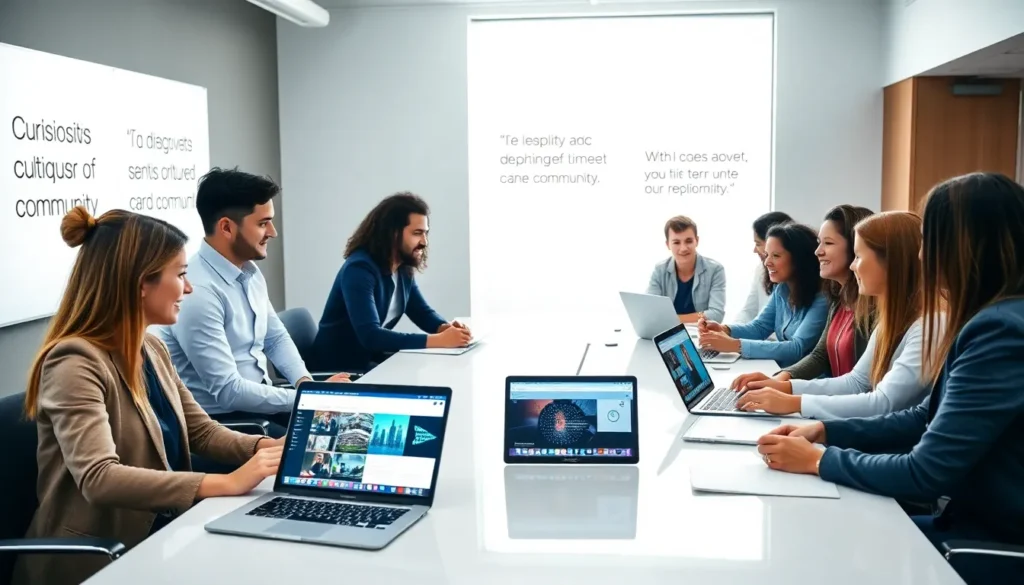In a world buzzing with self-help gurus and motivational quotes plastered on coffee mugs, it’s easy to mix up inspiration and motivation. They might seem like twins at first glance, but they’re more like distant cousins who never quite agree on the family reunion plans. Inspiration strikes like a lightning bolt, igniting creativity and passion, while motivation is the persistent little engine that keeps chugging along, pushing us to take action.
Understanding the difference can be a game-changer. Imagine trying to run a marathon fueled only by inspiration—great for the first mile but not so much for the last 25. On the flip side, motivation alone can feel like trying to push a boulder uphill without a good reason. Dive into the nuances of these two powerful forces and discover how to harness them for a more fulfilling journey toward your goals.
Table of Contents
ToggleUnderstanding Inspiration vs Motivation
Inspiration and motivation are often confused, yet they serve distinct purposes. Recognizing these differences is crucial for personal growth and goal achievement.
Definition of Inspiration
Inspiration refers to a burst of creativity that prompts individuals to explore new ideas. It often arises unexpectedly, igniting passion and driving one towards a creative endeavor. Artists, writers, and innovators frequently experience inspiration as a sudden urge to create. Such moments may come from various sources, including nature, art, or a profound statement. Often, inspiration serves as the catalyst for change, pushing individuals outside their comfort zones. This phenomenon encourages exploration, as it taps into one’s inner thoughts and feelings.
Definition of Motivation
Motivation functions as a consistent force that propels individuals to take actionable steps. It typically derives from personal goals or external rewards, providing the necessary drive to complete tasks. People can experience both intrinsic motivation, fueled by personal satisfaction, and extrinsic motivation, driven by external factors such as praise or monetary rewards. Establishing clear objectives enhances motivation, turning aspirations into attainable goals. Unlike inspiration, motivation can involve discipline and perseverance, requiring individuals to stay the course even when enthusiasm wanes.
The Role of Inspiration

Inspiration serves as a powerful catalyst, often igniting creativity and passion. It emerges unexpectedly, drawing from various sources.
Sources of Inspiration
Nature, art, personal experiences, and stories from others often spark inspiration. Each source can evoke strong emotions and new ideas, leading individuals to explore their creativity. Observing a stunning sunset may lead someone to create a poem, while reading an impactful book can inspire someone to pursue a new career path. These moments highlight how life provides numerous opportunities for inspiration, propelling individuals toward growth and change.
Impact on Creativity and Innovation
Inspiration directly influences creativity and innovation. When individuals encounter an inspiring idea, they often envision new possibilities, transforming their thoughts into tangible creations. An inspired artist may develop a unique style, while an inspired entrepreneur might launch a groundbreaking product. This process encourages thinking outside conventional boundaries, fostering an environment where novel solutions thrive. By recognizing the importance of inspiration, individuals can unlock their creative potential and drive innovation in their respective fields.
The Power of Motivation
Motivation serves as a critical driving force behind actions and decisions. It enables individuals to pursue their goals with determination and focus.
Types of Motivation
Intrinsic and extrinsic represent two primary types of motivation. Intrinsic motivation derives from within, fueled by personal satisfaction or passion for an activity. Examples include studying a subject for the joy of learning or pursuing a hobby. Extrinsic motivation, on the other hand, originates externally. Rewards like money, praise, or recognition often inspire this type. For instance, a person may work overtime to receive a financial bonus or to earn praise from a supervisor. Recognizing these types is essential to effectively harness motivation in personal and professional settings.
Influence on Goal Achievement
Motivation significantly influences goal achievement. It transforms aspirations into reality by fostering commitment and persistence. High motivation levels often lead to increased productivity and a dedicated effort toward overcoming obstacles. For example, students who remain motivated consistently achieve higher academic performance. Additionally, employees exhibiting strong motivation contribute positively to team dynamics and company success. Without motivation, even the most ambitious goals may become unattainable, illustrating the importance of sustaining motivation throughout the journey toward accomplishment.
Comparing Inspiration and Motivation
Understanding the interplay between inspiration and motivation requires grasping their unique characteristics and how they complement each other.
Key Differences
Inspiration comes as a spontaneous burst, often igniting creativity and new ideas. For example, someone might feel inspired after a breathtaking nature scene. Motivation, however, serves as a consistent driving force, encouraging individuals to work toward defined goals. It often relies on intrinsic or extrinsic elements, whether personal satisfaction or external rewards. While inspiration sparks action, motivation maintains momentum. Individuals may find inspiration fleeting, yet motivation can persist, guiding people through challenges.
How They Work Together
Inspiration and motivation interact to enhance personal growth and achievement. When inspiration strikes, it can propel individuals to set ambitious goals, transforming fleeting ideas into actionable plans. Motivation helps in executing those plans, providing the discipline needed to achieve long-term success. As motivation sustains focus, inspiration can reappear, fueling creativity in times of stagnation. By integrating both elements, individuals cultivate a dynamic process that encourages innovation and resilience. Together, they create a powerful synergy, allowing for both creativity and sustained effort in pursuit of goals.
Understanding the difference between inspiration and motivation is essential for personal and professional growth. Inspiration acts as a spark that fuels creativity while motivation provides the steady drive needed to achieve goals. Recognizing how these two forces complement each other allows individuals to harness their full potential.
By embracing moments of inspiration and cultivating motivation, one can navigate challenges more effectively. This synergy not only fosters innovation but also builds resilience in the face of obstacles. Ultimately, balancing inspiration and motivation creates a pathway toward meaningful achievements and lasting fulfillment.









